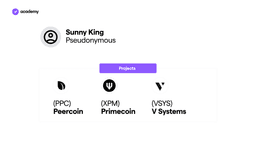Who is Sunny King, the inventor of Proof-of-Stake?
April 15, 2022
7 min

Innovation in every crypto and blockchain project has a fundamental technological component, made up of protocols and algorithms. The first was Bitcoin, which introduced Proof-of-Work (PoW) as a consensus mechanism, critical to block creation and network security. Satoshi Nakamoto thus gave life to a new economic reality. But who pursued the idea of decentralisation?
A certain Sunny King inherited the role of anonymous genius and, with the first implementation of Proof-of-Stake (PoS), revolutionised consensus mechanisms.
Who is the inventor of Proof-of-Stake?
We know very little about Sunny King’s life, so much so that recalling the crucial events of his career will seem like an epic fairytale: in 2011, an unnamed man gathered a group of researchers to create a technology that could replace Bitcoin.
The unknown knight called himself Sunny King: he reached the castle of the legendary Satoshi to challenge the power of the PoW giant with the lightness of PoS, in order to reclaim the blockchain kingdom. Nothing else is known about his identity, so the protagonist of this story could be anyone: concealing his face highlights the work, the message and the ideals.
Let’s consider, however, that only the protagonist gets remembered from every story, but the original idea of PoS may not belong to our champion. Although Sunny King really was the first to accomplish the feat, the concept of Proof-of-Stake probably came from someone else.
On 11 July 2011, on bitcointalk.org – the forum Satoshi created to discuss blockchain – a visionary user suggested replacing Bitcoin mining with a voting system, based on proof of token ownership, wherethose who didn’t want to actively verify transactions would also have the option to delegate.
The anonymous user hypothesised a system of rewards on a random basis for stakeholders, as well as possible advantages such as greater speed, reliability and participation, though specifying that this was only an idea and he was seeking feedback from someone more qualified.
All in all, this post contains the embryo of the consent mechanism implemented by Sunny King, to the extent that its name is “proof-of-stake instead of proof-of-work”, or “PoS instead of PoW”.
Scalability and consent without waste
The best adventures always have a twist: the author of the topic disappeared from the forum four days later. Thus the birth of the first Proof-of-Stake cryptocurrency got no response from the first to conceive it: QuantumMechanic. Another mysterious pseudonym that could even conceal the same person, as far as we know.
In any case, why did Sunny choose to develop this idea, first timidly put forward in a niche forum? We are told the motivation in this rare interview, where we discover that, with PoS, Sunny essentially intended to break the link between decentralisation and energy consumption.
With Bitcoin, computational power doesn’t only mean energy consumption – hence its environmental cost – but is also a limit to scalability. BTC is substantially hampered by its consensus mechanism in becoming the centre of decentralised finance (DeFi), unless it leverages Layer 2 solutions such as the Lightning Network.
In addition, the very security of Bitcoin depends on the work of the miners, who are paid with new coins. However, in the long term, given the maximum number of 21 million tokens, mining incentives will only consist of transaction fees. Will it really be worth the trouble?
Peercoin: the first Proof-of-Stake cryptocurrency
So Sunny King designed, together with Scott Nadal, the first cryptocurrency based on a Proof-of-Stake blockchain: Peercoin, whose white paper was published on 19 August 2012. The PPC protocol, so expressly green that it’s represented by a green leaf, was the first alternativeto Bitcoin’s PoW, even being celebrated by a very young Vitalik Buterin (who went on to create Ethereum).
The operation of this first historic example of Proof-of-Stake was incentivised through rewards in PPC, paid for each block created. The same token was staked as collateral to verify transactions. The greater the stake, the greater the probability of being chosen for the validation of the next block.
At the base of Peercoin’s Proof-of-Stake is another scarce resource: time, because, in addition to the number of tokens owned by network participants, the second criterion for selecting validators is how long they’ve owned their PPC.
To the quantity and time criteria is added a layer of randomness, which makes the selection of the next validator even more equitable.
The result of this system is that the blockchain belongs to all its stakeholders, which makes it much more decentralised than a system with high entry barriers such as mining.
However, Peercoin didn’t give up PoW altogether: it used miningto distribute the initial supply of coins fairly. A small price to promote a more decentralised division than usual: the first tokens issued are often destined mostly for venture capital, development teams and other centralised entities. Thus the circulation of the first tokens, generated by mining, gave rise to the first stakes, which would then replace the miners themselves. Today, we know that there are several alternatives for spreading a currency on the market, including ICOs.
According to the inventor of Proof-of-Stake, moreover, the last battle of its tokenomics had to be inflation, in the sense of a gradual increase in the supply of PPC – in this case, 1%. In his opinion, this little trick would let PPC avoid the same fate as Bitcoin. Sunny also decided to offset this inflation rate with the burning of transaction fees.
Primecoin: in search of prime numbers
It is precisely the minimal and strategic use of mining that reveals the motivationsthat drove Sunny: social utility and pragmatism.
With these inspirations, in 2013, he invented Primecoin, this time based entirely on proof-of-work. In this case, however, the energy consumption has a practical purpose, besides merely creating blocks.
Unlike Bitcoin, Primecoin doesn’t force miners to solve mathematical problems for their own sake: its protocol doesn’t produce hash codes, but aims to find new sets of prime numbers. These results thus have a value beyond the mining process: they can be used by mathematicians and scientists from various fields. Sunny King believes that these sequences (twin prime chains) can be used as indicators for the Kardashev scale, a measure of a civilisation’s technological level.
V Systems: the social value of cryptocurrencies
“Cryptocurrencies need moral character,” Sunny comments on his third project, V Systems. Initially called Virtual Economy Era (VEE), then rebranded as VSYS, it is a blockchain to create blockchains that are scalable, accessible and economical.
Imagine creating your avatar by choosing its hair colour, height and clothes: in the same way, V Systems lets you select features to customise your blockchain. This allows the development of decentralised applications (dApps) – not only financial ones, but also for social and impact purposes.
The goal is to make it easy to build decentralised solutions, so as to create a self-sufficient crypto ecosystem: the future for Sunny King doesn’t lie in a few billion-dollar projects, but in millions of blockchains, all managed through variants of proof-of-stake.
Similarly, the inventor of Proof-of-Stake believes that the future of the virtual economy lies in the concept of ownership and in the possible successor of Bitcoin: “So for thousands – or even more – of other cryptocurrencies, don’t lose hope yet.”



